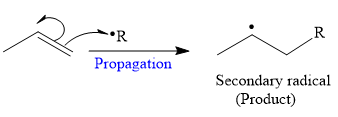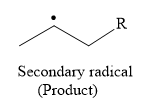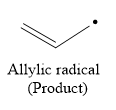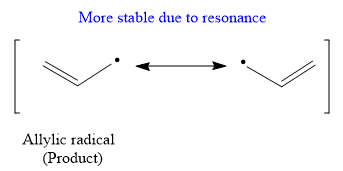
(a)
Interpretation:
Propylene does not undergo free radical
Concept introduction:
In any free radical polymerization reaction generally, three steps are involved viz. initiation, propagation, and termination. In initiation step, free radicals are generated from either monomer or from another compound such as hydrogen peroxide or benzoyl peroxide called a radical initiator. In propagation, step radicals react with the monomer to grow the chain to build up ![]() ) is used to represents the movement of a single electron in a homolysis process.
) is used to represents the movement of a single electron in a homolysis process.
Answer to Problem 26.37P
Propylene does not undergo free radical polymerization readily because there are two competing steps after initiation: propagation and hydrogen atom abstraction. The mechanism and products for these two competing steps are given below:


Explanation of Solution
The mechanism for the propagation and its corresponding product for a given reaction is shown below:

So in the propagation step, secondary radical is formed as a product.

The mechanism for the hydrogen atom abstraction and its corresponding product in a given reaction is shown below:

So in the hydrogen atom abstraction step, allylic radical is formed as a product.

Propylene does not undergo free radical polymerization readily because there are two competing steps after initiation: propagation and hydrogen atom abstraction. The mechanism and products for these two competing steps are drawn.
(b)
Interpretation:
Propylene does not undergo free radical polymerization readily because there are two competing steps after initiation: propagation and hydrogen atom abstraction. It is to be explained which step produces a more stable product.
Concept introduction:
In any free radical polymerization reaction generally, three steps are involved viz. initiation, propagation, and termination. In initiation step, free radicals are generated from either monomer or from another compound such as hydrogen peroxide or benzoyl peroxide called a radical initiator. In propagation, step radicals react with the monomer to grow the chain to build up polymer and this process is called a chain-growth polymerization or addition polymerization. Finally, in terminating step, the growth of polymer is stopped by two ways: combination or disproportionation. In combination step, two growing polymer radicals combine to form the uncharged product, polymer. The termination occurs when the one radical abstracts a hydrogen atom from another radical is called disproportionation. The breaking of a covalent bond, whereby the electrons making up that bond are distributed equally to the atoms which are disconnected is known as the homolytic bond dissociation or homolysis. So in homolysis generally radicals are formed. In homolysis, a covalent bond is a breakdown equally and each atom acquires a single electron which is called a radical and a single barbed arrow (![]() ) is used to represents the movement of a single electron in a homolysis process. The weakest bond possesses the smallest
) is used to represents the movement of a single electron in a homolysis process. The weakest bond possesses the smallest
Answer to Problem 26.37P
Due to resonance stabilization, an allylic radical is more stable than the secondary radical.
Explanation of Solution
The products of both these steps are:


The stability order of the radical is

Propylene does not undergo free radical polymerization readily because there are two competing steps after initiation: propagation and hydrogen atom abstraction. It is explained which step produce a more stable product on the basis of the stability of radicals.
(c)
Interpretation:
Propylene does not undergo free radical polymerization readily because there are two competing steps after initiation: propagation and hydrogen atom abstraction. It is to be explained why propylene is poor reactive in free radical polymerization.
Concept introduction:
In any free radical polymerization reaction generally, three steps are involved viz. initiation, propagation, and termination. In initiation step, free radicals are generated from either monomer or from another compound such as hydrogen peroxide or benzoyl peroxide called a radical initiator. In propagation, step radicals react with the monomer to grow the chain to build up polymer and this process is called a chain-growth polymerization or addition polymerization. In a such case for propagation step less stable radical must be formed. Finally, in terminating step, the growth of polymer is stopped by two ways: combination or disproportionation. In combination step, two growing polymer radicals combine to form the uncharged product, polymer. The termination occurs when the one radical abstracts a hydrogen atom from another radical is called disproportionation. The breaking of a covalent bond, whereby the electrons making up that bond are distributed equally to the atoms which are disconnected is known as the homolytic bond dissociation or homolysis. So in homolysis generally radicals are formed. In homolysis, a covalent bond is a breakdown equally and each atom acquires a single electron which is called a radical and a single barbed arrow (![]() ) is used to represents the movement of a single electron in a homolysis process. The weakest bond possesses the smallest bond dissociation energy. The stability order for radicals is
) is used to represents the movement of a single electron in a homolysis process. The weakest bond possesses the smallest bond dissociation energy. The stability order for radicals is
Answer to Problem 26.37P
In free radical polymerization reaction less stable radical must be formed to propagate the chain. But in given case more stable, allylic carbocation is formed which affects the propagation step results in rate of polymerisation is very low.
Explanation of Solution
The products of the both steps in free radical polymerization of propylene are given below:


Due to the formation of more stable, allylic radical in hydrogen atom abstraction step it will interfere with the formation of polymer.

In free radical polymerization reaction less stable radical must be formed to propagate the chain. But in given case more stable, allylic carbocation is formed which affects the propagation step results in rate of polymerisation is very low.
Propylene does not undergo free radical polymerization readily because there are two competing steps after initiation: propagation and hydrogen atom abstraction. It is explained why propylene is poor reactive in free radical polymerization.
Want to see more full solutions like this?
Chapter 26 Solutions
EBK GET READY FOR ORGANIC CHEMISTRY
- CH, CH CH₂ CH₂ Phytyl side chain 5. What is the expected order of elution of compounds A-D below from a chromatography column packed with silica gel, eluting with hexane/ethyl acetate? C D OHarrow_forwardPlease analze my gel electrophoresis column of the VRK1 kinase (MW: 39.71 kDa). Attached is the following image for the order of column wells and my gel.arrow_forward2.0arrow_forward
- Write the electron configuration of an atom of the element highlighted in this outline of the Periodic Table: 1 23 4 5 6 7 He Ne Ar Kr Xe Rn Hint: you do not need to know the name or symbol of the highlighted element! ☐arrow_forwardCompare these chromatograms of three anti-psychotic drugs done by HPLC and SFC. Why is there the difference in separation time for SFC versus HPLC? Hint, use the Van Deemter plot as a guide in answering this question. Why, fundamentally, would you expect a faster separation for SFC than HPLC, in general?arrow_forwardA certain inorganic cation has an electrophoretic mobility of 5.27 x 10-4 cm2s-1V-1. The same ion has a diffusion coefficient of 9.5 x 10-6cm2s-1. If this ion is separated from cations by CZE with a 75cm capillary, what is the expected plate count, N, at an applied voltage of 15.0kV? Under these separation conditions, the electroosmotic flow rate was 0.85mm s-1 toward the cathode. If the detector was 50.0cm from the injection end of the capillary, how long would it take in minutes for the analyte cation to reach the detector after the field was applied?arrow_forward
- 2.arrow_forwardPlease solve for the following Electrochemistry that occursarrow_forwardCommercial bleach contains either chlorine or oxygen as an active ingredient. A commercial oxygenated bleach is much safer to handle and less likely to ruin your clothes. It is possible to determine the amount of active ingredient in an oxygenated bleach product by performing a redox titration. The balance reaction for such a titration is: 6H+ +5H2O2 +2MnO4- à 5O2 + 2Mn2+ + 8H2O If you performed the following procedure: “First, dilute the Seventh Generation Non-Chlorine Bleach by pipetting 10 mL of bleach in a 100 mL volumetric flask and filling the flask to the mark with distilled water. Next, pipet 10 mL of the diluted bleach solution into a 250 mL Erlenmeyer flask and add 20 mL of 1.0 M H2SO4 to the flask. This solution should be titrated with 0.0100 M KMnO4 solution.” It took 18.47mL of the KMnO4 to reach the endpoint on average. What was the concentration of H2O2 in the original bleach solution in weight % assuming the density of bleach is 1g/mL?arrow_forward
- 10.arrow_forwardProper care of pH electrodes: Why can you not store a pH electrode in distilled water? What must you instead store it in? Why?arrow_forwardWrite the electron configuration of an atom of the element highlighted in this outline of the Periodic Table: 1 23 4 569 7 He Ne Ar Kr Xe Rn Hint: you do not need to know the name or symbol of the highlighted element! §arrow_forward
 ChemistryChemistryISBN:9781305957404Author:Steven S. Zumdahl, Susan A. Zumdahl, Donald J. DeCostePublisher:Cengage Learning
ChemistryChemistryISBN:9781305957404Author:Steven S. Zumdahl, Susan A. Zumdahl, Donald J. DeCostePublisher:Cengage Learning ChemistryChemistryISBN:9781259911156Author:Raymond Chang Dr., Jason Overby ProfessorPublisher:McGraw-Hill Education
ChemistryChemistryISBN:9781259911156Author:Raymond Chang Dr., Jason Overby ProfessorPublisher:McGraw-Hill Education Principles of Instrumental AnalysisChemistryISBN:9781305577213Author:Douglas A. Skoog, F. James Holler, Stanley R. CrouchPublisher:Cengage Learning
Principles of Instrumental AnalysisChemistryISBN:9781305577213Author:Douglas A. Skoog, F. James Holler, Stanley R. CrouchPublisher:Cengage Learning Organic ChemistryChemistryISBN:9780078021558Author:Janice Gorzynski Smith Dr.Publisher:McGraw-Hill Education
Organic ChemistryChemistryISBN:9780078021558Author:Janice Gorzynski Smith Dr.Publisher:McGraw-Hill Education Chemistry: Principles and ReactionsChemistryISBN:9781305079373Author:William L. Masterton, Cecile N. HurleyPublisher:Cengage Learning
Chemistry: Principles and ReactionsChemistryISBN:9781305079373Author:William L. Masterton, Cecile N. HurleyPublisher:Cengage Learning Elementary Principles of Chemical Processes, Bind...ChemistryISBN:9781118431221Author:Richard M. Felder, Ronald W. Rousseau, Lisa G. BullardPublisher:WILEY
Elementary Principles of Chemical Processes, Bind...ChemistryISBN:9781118431221Author:Richard M. Felder, Ronald W. Rousseau, Lisa G. BullardPublisher:WILEY





